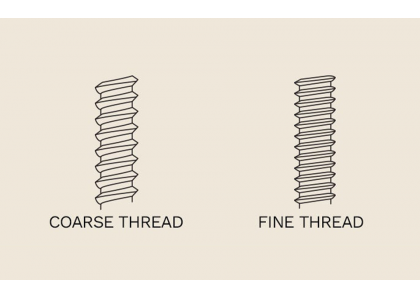
Definition of fastener thread
A thread is a shape with a uniform helix protruding on a solid outer or inner surface. The main thread organic thread, self-tapping thread, self-drilling thread three kinds.
Machine thread: when assembling, drill holes and tap thread on the assembly first. The tapped inner thread have the same specifications as the outer thread of the screw, and assemble with small torque.
Self-tapping thread: When assembling, drill holes on the assembly first, do not need to tap the inner thread, and use large torque assembly.
Self-drilling thread: directly used on the assembly, screw drilling and tapping molding.
Screw action of fastener
1. Fastening and connecting function: suitable for most screw products at this stage. 2. Transmission action (displacement action): such as the micrometer used by QC to check the size. 3. Sealing effect: such as pipe connection sealing.
Coarse thread and fine thread
The so-called coarse thread can be defined as the standard thread; The fine thread is relative to the coarse thread, under the same nominal diameter, the number of thread contained per inch is different, that is, the pitch is different, the coarse thread pitch is large, and the fine thread pitch is small. In other words, for the 1/2-13 and 1/2-20 specifications, the former is a coarse thread and the latter is a fine thread. It is therefore expressed as 1/2-13UNC and 1/2-20UNF.
Coarse thread
Definition: The so-called coarse thread actually refer to the standard thread. The characteristics of coarse thread: it has high strength, good interchangeability, and there are standards to compare, generally speaking, coarse thread should be the best choice; Ratio with fine thread: because the pitch is large, the thread rise Angle is also large, self-locking is poor, in the vibration environment need to install anti-loose washer, self-locking device, etc.; The advantage is that it is convenient to disassemble and assemble, and the supporting standard parts are complete and easy to exchange;
Fine thread
Definition: fine thread and coarse thread are the opposite, in order to supplement the coarse thread can not meet the special use requirements and provisions, fine thread also has a pitch series, fine thread pitch is smaller, so its characteristics are more beneficial to self-locking, anti-loose, and the number of thread, can reduce the effect of leakage, to achieve the effect of sealing. In some precision occasions, fine-threaded stainless steel screws are more convenient for precise control and adjustment.
Disadvantages: The tensile value and strength are low, and the thread is easy to damage, it is not recommended to disassemble and assemble several times, and the supporting nuts and other fasteners may be equally accurate, and the size is slightly wrong, which is easy to make the screws and nuts damaged at the same time.
Application: Fine thread is mainly used in hydraulic system metric pipe fittings, mechanical transmission parts, thin wall parts with insufficient strength, internal parts limited by space and shaft with high self-locking requirements. When marking fine thread, the pitch must be marked to show the difference with coarse thread.
How to choose coarse and fine thread
Coarse thread and fine thread screws are used for fastening. Fine thread screws are generally used to lock thin-walled parts and parts with high vibration resistance requirements. The self-locking performance of fine thread is good, so the ability to resist vibration and loosen is strong, but because the depth of thread thread is shallow, the ability to withstand greater tension is worse than that of coarse thread. When no anti-loosening measures are taken, the anti-loosening effect of fine thread is better than that of coarse thread, which is generally used for thin-walled parts and parts with high anti-vibration requirements. For adjustment, fine thread has the advantage. The disadvantages of fine thread: it is not suitable for application on materials with excessive coarse organization and poor strength, and it is easy to slip when the tightening force is too large.